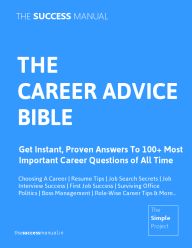On February 16, 2025 By thesuccessmanual Topic: Remarkable, Quotes, Book summaries free, Book summaries online, Book summaries for business students
This summary is from The Success Manual, The Encyclopedia of Advice. A list of all the articles in the series on one page can be accessed here.
You will also want to read 100 ways to be remarkable, articles from The Success Manual.
The idea behind The Sucess Manual is simple: you do not need expensive business sources and books to excel at work and in life. Read about this idea here.
The Success Manual provides you with advice on 130 topics in all - 65 business topics and 65-odd personal development topics.
People do best when they're working at 80 percent of their capacity. At 50 percent, they get bored. At 100 percent, stress gets them.
- Anon
1. MANAGEMENT BY OBJECTIVES: The term introduced by Peter Drucker in “The Practice of Management” in 1954 . The system of MBO is a process whereby all the managers of an organization jointly identify its common goals, define each individual’s major areas of responsibility in terms of results expected of him, and use these measures as guides for operating the unit and assessing the contribution of each of its members. MBO shifts the focus to goals, to the purpose of the activity rather than the activity itself. Instead of asking “ What do I do?” the manager is led to ask “ What is the objective towards which we are working?” Under the concept, the manager is held responsible for results rather than for activities.
8 Areas of objectives: Drucker says there are 8 areas in which objectives should be set: Market standing, innovation, productivity, physical and financial resources, profitability, manager performance and development, worker performance and attitude, and Public Responsibility.
Development of objectives is the manager’s first responsibility. The task of objective-setting should be pushed as far down the organization chart as possible. Drucker also advises ‘self control’ while setting the objectives. The objectives should also serve the ‘public good’; the general welfare (common weal)
2. HAWTHORNE EXPERIMENT: conducted in the late 1920s by Elton Mayo and his Harvard Business School associates at the Hawthorne, Illinois, plant of the Western Electric Company. The essence of the Hawthorne effect lay in the following sequence -first, workers were given better working conditions; brighter lights, more pleasant surroundings, and so on. Their production went up. Then the improvements were taken away. Production continued to go up/ Then conditions were intentionally worsened and the work much more monotonous. Productivity continued to increase and workers remained fresh and satisfied. WhyThe answer lay in the fact of the experiment itself. Workers would produce as long as someone was paying attention to them. After interviewing them ,
Mayo had found that the workers had performed better because during the experiment they were being treated better by their supervisors. The assembly line workers were further motivated because their menial tasks acquired greater meaning as part of an experiment.
3. BRAINSTORMING: Advertising executive Alex Osborne explained persuasively that creativity could b unleashed through the medium of ‘brainstorming’
4. THE MANAGEMENT GRID: Developed in the 1960s by Robert R. Blake and Jane S. Morton of the University of Texas , the ‘Grid’ is a rectangular framework in which managers are rated from very low to very high in their concern for people and their concern for production. At one corner would be the boss who does not a give a damn for workers but who goes all out to get the job done. At another corner would be the executive who is all-consumed with the establishment of rapport but who will let productivity lag because of his sympathy with people. A 1/1 would be the lowest rating. A 9/9 ranks the executive as optimum in his concern for production and for personnel.
5. KNOWLEDGE WORKER/KNOWLEDGE INDUSTRIES: The centerpiece of an economy dominated by the processing knowledge initially attributed to Peter Drucker (‘The age of discontinuity’) and Alvin Toffler (‘Future Shock’) and Fritz Machlup (‘Production and distribution of knowledge in the US’).
6. HYGIENE THEORY: Attributed to Dr. Frederick Herzberg in 1959 in his book “The Motivation to work” ( co-authored by Bernard Mausner and Barbara Snyderman). The Hygiene Theory is a widely influential proposition devoted to determining the things that impel people to work more effectively. Through a set of studies, Herzberg and the co-authors identified two sets of conditions that affect a worker. One set of conditions has the power to satisfy. The most important motivators are: achievement, recognition, the work itself, responsibility, and advancement. All of these factors are intrinsic to the job. The other set of conditions affecting the workers are ‘dissatisfiers’ or ‘hygiene factors’. These are factors that have only a negative effect. When they are absent, or deficient, they cause the worker to be dissatisfied. But they cannot satisfy, and no matter how abundantly they are provided for the worker- they cannot motivate him to do a better job. The leading hygiene factors are - company policy and administration, supervision, interpersonal relations, working conditions, and salary. Herzberg maintained that money is not a true motivator. If you do not pay a man enough, true, he will become unhappy. But above a certain point, you cannot motivate him through money.
7. THEORY X, THEORY Y AND THEORY Z: Articulated by late Douglas Mcgregor in his book , “The human side of Enterprise”, the essence of Theory X and Theory Y” proposition is that there are two theoretical assumptions relating to the management of people. Executives deal with subordinates according to one assumption or another. The traditional assumption, which McGregor called ‘Theory X’- is that the average human being has an inherent dislike of work and will avoid it if he can. He prefers to be directed, avoids responsibility, has little ambition, and wants security above all. Because of this human characteristic, the worker must be controlled, coerced, and threatened in order to get him to make an adequate effort. Theory X, said Mcgregor, was the way most bosses dealt with people. It led to ‘carrot and stick’ management. And it was not a good way to manage.
So, in place of Theory X, Mcgregor suggested Theory Y. This formulation states that working is a s natural as playing or resting; that people want to work and achieve; that the average human being learns, under proper conditions, not only to accept but to seek responsibility; and that the intellectual potentialities of the average worker were only partially utilized. Therefore, says Theory Y, external control and the threat of punishment are not the only ways to bring about effort:” Man will exercise self-direction and self-control in the service of objectives to which he is committed.”
Theory Z: An improvement on Theory Y by William Ouchi in the 1980s. Using Z, the Japanese bring together management and workers in cohesive work groups. Every one is part of a consensual-decision making process. To improve quality, workers and management work together in ‘Quality Circles’. Every employee is involved in ‘Kaizen’ - the continuous struggle necessary to improve all aspects of the self and of the company. When workers feel like partners in the business, they become more productive and committed to their jobs. Many experts believe the competitive surge of Japanese Business in the 1980s and early 1990s owed to Theory Z.
8. MBWA: SHORT FOR MANAGEMENT BY WALKING AROUND: A theory expounded at information technology major Hewlett-Packard. HP executives were encouraged to be out of their offices, working on building relationships, motivating, and keeping in direct touch with the activities of the company. It is a very simple but useful concept
9. TOTAL QUALITY MANAGEMENT: Management philosophy dedicating the entire organization to a relentless quality- centered effort. In TQM, quality means meeting or exceeding the requirements of one’s customers. the customers can be the end users of a product, another department within a company or even a supplier.
W.Edwards Demming , the father of the TQM theory, believed that management shortcomings-rather than careless workers-caused most product defects. He taught that getting it right the first time beats out inspections after the fact. His system no only improved product quality but also cut back drastically on parts that must be scrapped or reworked, thereby cutting costs.
It was in the 1980s that TQM really caught the fancy of businessmen all over the world, like in the U.S. They started believing that quality is no an expensive way to do business -rather an efficient one. W.Edwards Demming who was a hard worker right into old age. he died at the age of 93 in 1993. He did no like slogans and never accepted the term total quality management.
Experts, consultants and like have all come up with their versions of Deming’s approach. All these can be summarized below as:
1. Create constancy of purpose: This means, in part, taking a long-term view of the organization as an entity with a mission-to stay in business and provide jobs through employing quality techniques.
2. Adopt the new philosophy: The new philosophy does not accept mistakes and poor products but knows the value of high quality.
3. Stop depending on mass inspection: Mass inspection means acceptance of a large number of defects, in effect paying workers to make defective products and rewards them.
4. Stop awarding business to the lowest bidder: That may compromise quality.
5.Improve constantly and forever: Quality is a never ending process. This is similar to continuous improvement.
6. Institute training
7. Institute leadership: Leadership means helping people do a better job; as opposed to management which is telling workers what to do and punishing them for failure.
8. Drive out fear: fear in the workplace prevents people from doing what is right.
9.Break down barriers between staff areas: This involves working towards the same goal instead of at cross-purposes.
10. Eliminate slogans and targets for the workforce: Deming thought that instead of improving quality it insulted workers who are hungry for better ways to do their jobs.
11. Eliminate numerical quotas: Quotas do not measure quality but encourage high output and a large number of defects.
12. Remove barriers to pride of workmanship: Workers want to produce great products and services, but too often , the wrong equipment, lack of training, and poor supervision stand in the way.
13. Institute a vigorous program of education: This means education in the new methods to improve quality-as opposed to training in specific job tasks.
14. Take action to build quality: Top management must lead the change, understand the quality tools, and practice them.
A list of articles from The Success Manual, on one page can be accessed here. You can get The Success Manual here

